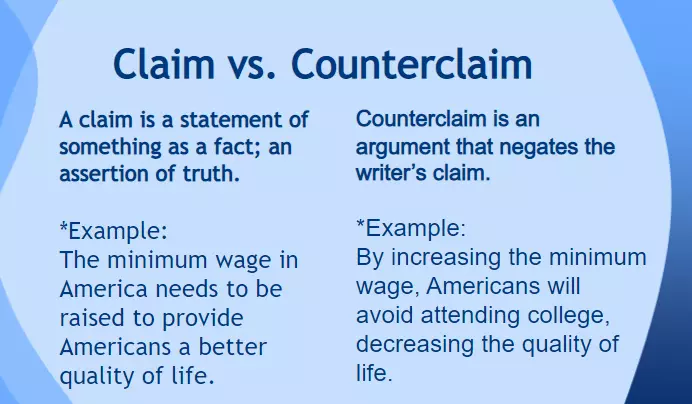

If you are writing an argumentative essay, you will find yourself including counterclaims. In this guide, we guide you on how to write a good counterclaim in an essay and how to frame your counterclaim sentence and paragraph in rebuttal.
Counterclaims are mostly included in an argumentative essay where you are required to convince your readers to agree with your arguments and point of view concerning the topic in question.
A counterclaim can be regarded as the argument or arguments that oppose the thesis statement in your essay. Within the introduction, you introduce the topic and create a thesis statement in the last sentence that makes it clear to your audience the point(s) you want to prove and the strategy you will use to prove it.
The counterclaim demonstrates to the reader that you have put into consideration the perspectives of the opposing side and you find such perspectives to be weak.
As such, a counterclaim will allow you to respond to the potential arguments of your readers before they complete reading the essay.
Additionally, a counterclaim demonstrates that both sides of the debate have been put into consideration, hence strengthening your position.
There is a big difference between a claim and a counterclaim. When writing essays, one may need to include both in the same essay, especially when presenting an argumentative topic.
The difference between a claim and a counterclaim lies in their assertion. A claim is a statement that demonstrates the position of argument or the assertion of a fact or a truth. On the other hand, a counterclaim is an argument that negates a specific claim by rebutting it. While a claim asserts the writer’s argument, a counterclaim rebuts.
When writing an essay, particularly an argumentative essay, you will have a topic and a thesis statement that will show the readers the points you are going to prove and how you will prove them.

Most of your paper will be dedicated to proving your claim to the reader so that they can agree with your point of view.
A good claim should be arguable and at times controversial to allow the readers to think otherwise about your perspectives as the writer.
It can also come up with their interpretations concerning the topic.
Because of this, the essay will be based on the claim and you will demonstrate why your claim is accepted. On the other hand, a counterclaim is a statement of opposition that will allow the readers to perceive the whole picture of the arguments.
Though this is the case, the counterclaim demonstrates that the writer has anticipated arguments against their claim and has provided proof, through the counterclaim, that the readers’ perspectives are false or weak.
As such, when the counterclaim is stated, it is addressed concerning its weaknesses or limitations. This enhances the claim’s strength.
If you wish to write a good counterclaim, make sure that it takes the form of two stages.

The first stage is where you go against your claim or argument so that you can challenge it and the second stage is where you turn back to your claim or argument to re-affirm it.
When writing a good counterclaim, you imagine that some of your readers will be skeptical and you have to make them agree with you.
For example, if you want to present a counterclaim showing that there was a problem with how you demonstrated your claims, like an unwarranted assumption, certain evidence was played down or ignored, and so on, you can support the counterclaim by presenting the disadvantages or drawbacks of the issues with the presentation. Then, give an alternative proposal or alternative that would make more sense to the readers.
To refute the counterclaim, you announce with words like ‘yet’, ‘but’, ‘however’, ‘still’, or ‘nevertheless’ to indicate that you are about to show why the counterclaim is wrong. Acknowledge that it is a good claim but demonstrate that yours might help the argument more.
A counterclaim can be included anywhere within the body of the essay except the conclusion. There are some cases where you can write a counterclaim at the second last sentence of the introduction paragraph followed by the thesis statement which acts as the refutation.
You can also write a counterargument after the introduction to show the anticipated reaction to your point of view before moving forward with writing your actual claims.
Moving forward, the reason why you cannot place the counterclaim within the conclusion is that you have to include a rebuttal paragraph or statements after you have written the counterclaim. Therefore, a counterclaim located at the conclusion will miss the rebuttal paragraph or statements.
However, argumentative essays can take different structures. Even though such essays will have a basic structure of an introduction, body paragraphs, and a conclusion, the differences will occur within the body paragraphs. Such differences dictate where the counterclaim(s) are located.
There is a structure where the counterclaims are located within all the body paragraphs. In this case, you will write your claim, followed by a counterclaim, and then a rebuttal. This means that for every claim you present to support your thesis, there will be a counterclaim and a rebuttal.
The most common structure is where you present your claims and present the counterclaim(s) before the conclusion. The counterclaim is immediately followed by a rebuttal.
When it comes to the dos of writing a counterclaim, always ensure that it is followed by a rebuttal to demonstrate that your claims are superior to it. Secondly, courteously present your counterclaims to avoid upsetting the reader.

Acknowledge the anticipated arguments from the readers.
Demonstrate that the readers’ points of view are valid but your perspective makes more sense.
Finally, appeal to the logic of the readers through the use of valid evidence.
Concerning the don’ts when writing a counterclaim, do not include a counterargument just for the sake of it.
Make sure that the counterargument is valid in its own right and it is verifiable through evidence.
This is because your readers will also use logic and evidence when thinking about your claims. Secondly, do not use a disrespectful or uncourteous tone when addressing the other side of the argument.
Counterclaim: “Opponents argue that after-school sports can increase the likelihood of sports-related injuries (Bancroft, 2018). Even minor injuries sustained from participation in after-school sports increase absent rates and the expense of creating injury reports for students (Sizemore, 2019)”.
Refutation: “Although students do suffer both serious and minor injuries in after-school sports, these injuries are quite rare (Kinney, 2016).
“Without free after-school sports programs, many students would still play sports without adult supervision and even more injuries would result”. Counterclaim: “However, some people would argue that after-school sports can increase the likelihood of sports-related injuries (Sizemore 2019)”. Refutation: “Although students do suffer both serious and minor injuries in after-school sports, without school-sponsored sports, the likelihood of more injuries from less supervised recreational leagues or privately sponsored leagues with fewer safety regulations would be much worse”.
A counterclaim can be as long as a paragraph if it appears after the introduction paragraph or at the end of the body before the conclusion. However, if a counterclaim is located within a paragraph, it can be a few sentences long (2-3).
However, the length of a counterclaim depends on the length of a claim in general. You can learn more about how to write a claim paragraph in that guide so that you can learn the two in general.
This depends on the structure of the essay. If the counterclaim appears after the introduction or before the conclusion, then it will only be one. However, if it is embedded within paragraphs, then they will be as many as the supportive augments.
This is because they will be used to refute every claim made within the body paragraph. If your supporting claims are 5 then the counterclaims will be 5 and so on.
Check out how to write college essays in our guide that we hope will lead you to score well.

Joseph is a freelance journalist and a part-time writer with a particular interest in the gig economy. He writes about schooling, college life, and changing trends in education. When not writing, Joseph is hiking or playing chess.